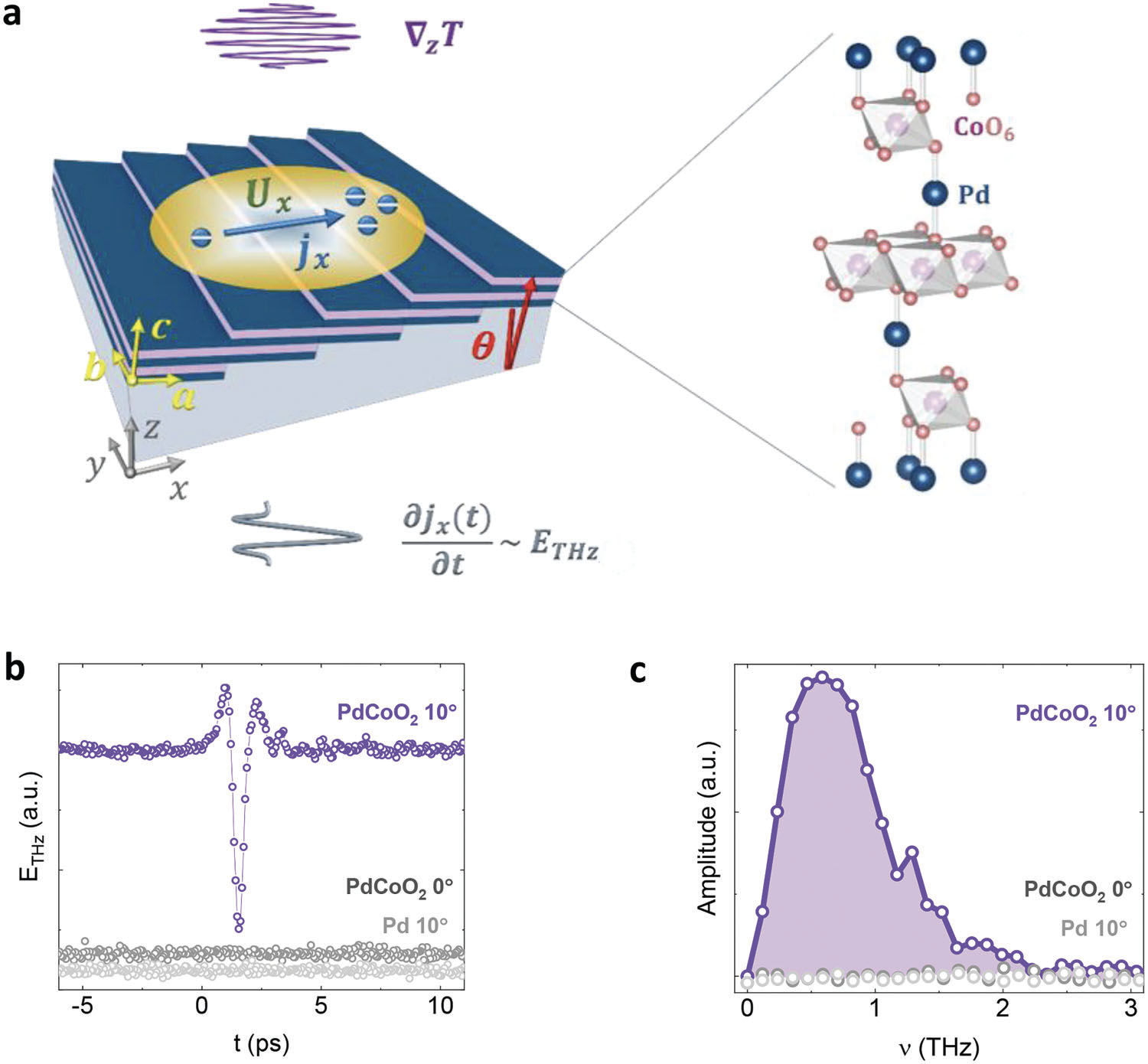| Sep 13, 2023 | |
New terahertz emitters harness natural material properties for nanoscale devices |
|
| (Nanowerk Spotlight) The development of compact and efficient terahertz radiation sources is crucial for the advancement of terahertz technology across a range of applications from imaging and sensing to broadband communications. | |
| In a new study published in Advanced Materials ("Generation of Terahertz Radiation via the Transverse Thermoelectric Effect"), researchers have demonstrated a simple yet powerful new approach for generating intense terahertz radiation using the natural properties of layered conductive metal oxides. | |
| Terahertz waves occupy the part of the electromagnetic spectrum between microwaves and infrared light. Their unique properties make them useful for applications like security screening, medical imaging, and next-generation wireless networks. | |
| However, the development of terahertz technology has been constrained by limitations in producing terahertz radiation efficiently. Most terahertz sources rely on external femtosecond lasers and intricate semiconductor or crystalline structures. | |
| The new technique utilizes a phenomenon called the transverse thermoelectric effect in atomically thin layered materials such as the metal oxide palladium cobalt oxide (PdCoO2). In these materials, the electrical conductivity and thermopower is highly anisotropic, meaning the properties are very different along perpendicular directions in the material. | |
| When a femtosecond laser pulse hits the PdCoO2 film, it creates an ultrafast temperature gradient perpendicular to the layers. This activates thermoelectric currents parallel to the layers, producing a directed terahertz radiation field. Because of the materials' layered structure and anisotropic properties, the terahertz output is efficiently emitted perpendicular to the film. | |
 |
|
| Generation of terahertz radiation via the transverse thermoelectric effect. a) Thin film of a material with anisotropic Seebeck coefficient deposited on an off-cut substrate for TTE-driven THz generation. Inset: Crystal structure of the delafossite PdCoO2, comprising metallic Pd and insulating CoO2 layers, with highly anisotropic structural and transport properties. b) Electric field strength and c) amplitude spectrum emitted from a thin film (d ≈ 10 nm) of PdCoO2 on a Θ = 10° off-cut Al2O3 substrate, as described in the text. Reference measurements on a PdCoO2 film grown on a regular Θ= 0° Al2O3 substrate, and on an elemental Pd film on a Θ = 10° Al2O3 substrate are also shown. (Reprinted with permission by Wiley-VCH Verlag) | |
| The researchers demonstrated the transverse thermoelectric effect's viability for terahertz generation in PdCoO2 films just 10 nm thick grown on angled "off-cut" substrates. The emission spectrum spanned up to 2.3 THz frequencies, comparable to commercial terahertz emitters. Through modeling, the team gained insights into how the terahertz intensity and bandwidth can be tuned by the material properties and film thickness. | |
| Notably, the terahertz output was achieved in simple, single-layer PdCoO2 films without any additional optical or electronic components. This makes the design highly versatile and integrable into nanoscale devices. The method was also verified in films of the layered superconductor La2-xSrxCuO4, confirming the transverse thermoelectric effect as the underlying mechanism. | |
| Compared to existing terahertz sources, the beauty of this approach is its conceptual simplicity and removal of constraints on operating conditions, materials, or temperatures. The researchers highlight the potential to further enhance performance and spectral bandwidth through materials optimization and engineering of the thermal gradient's ultrafast dynamics. | |
| The demonstrated intensity already rivals commercial terahertz emitters. With continued development, transverse thermoelectric emitters could unlock new capabilities in terahertz spectroscopy, communications, imaging, and sensing applications. Their thin-film geometry also makes them ideal candidates for integration into on-chip terahertz photonic circuits and hybrid nanodevices. | |
| Looking forward, the researchers plan to investigate interactions between the terahertz emission and exotic electronic states in customized oxide superlattices. By combining the terahertz source films with materials that exhibit properties like superconductivity and magnetism, they hope to add dynamic control and tuneability to the emission. | |
| Overall, this work demonstrates how innate material properties can be harnessed to achieve new functionalities. The researchers leveraged the atomic-scale layered anisotropy of metal oxides to create efficient, integrable nanoscale terahertz emitters. The novel approach overcomes limitations of existing terahertz sources and could help drive advances in integrated terahertz technology. | |
 By
Michael
Berger
– Michael is author of three books by the Royal Society of Chemistry:
Nano-Society: Pushing the Boundaries of Technology,
Nanotechnology: The Future is Tiny, and
Nanoengineering: The Skills and Tools Making Technology Invisible
Copyright ©
Nanowerk LLC
By
Michael
Berger
– Michael is author of three books by the Royal Society of Chemistry:
Nano-Society: Pushing the Boundaries of Technology,
Nanotechnology: The Future is Tiny, and
Nanoengineering: The Skills and Tools Making Technology Invisible
Copyright ©
Nanowerk LLC
|
|
|
Become a Spotlight guest author! Join our large and growing group of guest contributors. Have you just published a scientific paper or have other exciting developments to share with the nanotechnology community? Here is how to publish on nanowerk.com. |
|
